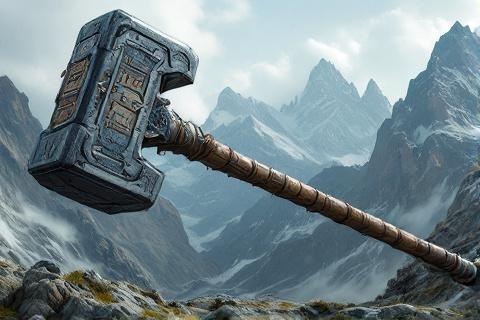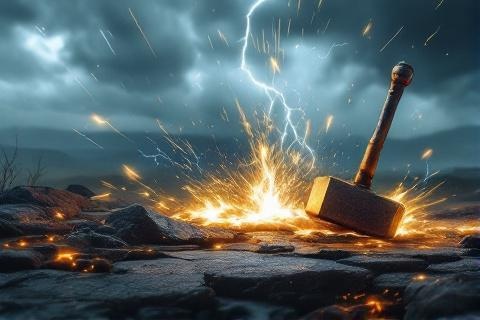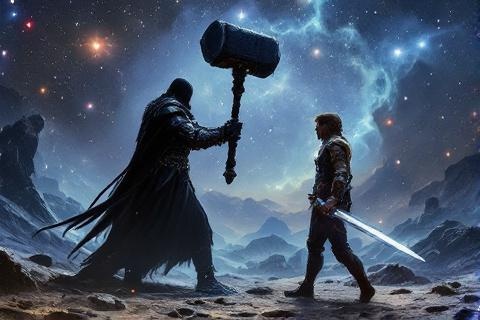
Grond
Hammer of the Underworld
The Meaning Behind the Name
The name Grond originates from the Sindarin language of the
Elves, where it simply means 'Club' or 'Hammer', aptly describing
the weapon's fundamental purpose as a devastating instrument of war. This
straightforward yet menacing name reflects the direct and brutal nature of the
weapon itself.
Grond earned its fearsome title 'Hammer of the Underworld' due to its creation
in the deepest forges of Angband,
Morgoth's fortress in the Iron Mountains of the North. The
depths of Angband were considered a hellish underworld, filled with fire and
darkness, making the epithet particularly fitting for a weapon of such terrible
power.
The legendary status of Grond influenced the naming of other weapons throughout
the ages of Middle-earth. Most notably, during the War of
the Ring in the Third Age, Sauron's
forces named their massive battering ram after this ancient weapon. This great
ram, used in the Siege of Minas Tirith, was built to honor the destructive
legacy of Morgoth's hammer.
Origins in Angband

Morgoth himself forged Grond in the infernal depths of his fortress Angband,
personally crafting it to be his signature weapon. The Dark Lord, being the
mightiest of the Valar, poured his own power and malice into its
making, ensuring it would be worthy of his stature and strength.
The hammer's creation took place during the First Age of
Middle-earth, when Morgoth's power was at its height and his dominion over the
northern lands was nearly absolute. This period marked the apex of his ability
to create weapons of incredible power, as he had not yet expended much of his
native strength in corrupting the world.
The forging process involved complex and malevolent enchantments, with Morgoth
weaving spells of terror and destruction into the very substance of the weapon.
These dark enchantments were designed to strike fear into the hearts of his
enemies, making them quail before the hammer was even raised.
The material chosen for Grond was black steel of extraordinary strength, which
Morgoth imbued with a portion of his own evil power and will. This infusion of
the Dark Lord's essence made the weapon far more than merely a physical
instrument of war, transforming it into a symbol of his might and malice.
Physical Description
The sheer size of Grond was staggering, matching the towering stature of Morgoth
himself, who stood far taller than any Elf or Man. The weapon's massive
proportions made it an imposing sight on any battlefield, visible from great
distances and inspiring dread in all who beheld it.
The black steel of the hammer's head bore intricate runes of power, carefully
inscribed by Morgoth to enhance its already formidable might. These runes glowed
with an evil light when the weapon was wielded in battle, adding to its
terrifying appearance and magical potency.
The handle of Grond was wrapped in dark materials of unknown origin, specially
prepared to allow Morgoth to wield the massive weapon effectively in combat.
These materials provided both grip and control, enabling the Dark Lord to swing
the enormous hammer with deadly precision.
Power and Capabilities

When Grond struck the earth, it created massive craters that permanently scarred
the landscape of Beleriand. These impacts were so powerful
that they could reshape the terrain, leaving lasting evidence of Morgoth's
destructive might that endured until the land's eventual submergence beneath the
sea.
The dark magic woven into Grond amplified its natural destructive capabilities
far beyond what even its immense size would suggest. This enchanted power made
each strike not just a physical blow, but a manifestation of Morgoth's own
malevolent will.
No shield or defensive fortification could withstand a direct hit from Grond, as
the combination of its physical mass and magical enhancement made it capable of
shattering any protection. Even the strongest works of Elven-smiths would crack
and fail before its terrible might.
Each strike of Grond produced thunderous explosions that could be heard for
leagues around, sending shock waves through the air and ground alike. These
terrifying sounds served as psychological warfare, breaking the morale of
Morgoth's enemies even before they faced him in direct combat.
Role in the War of Wrath
Grond saw its most significant use during the War of
Wrath, when the Valar finally moved against Morgoth in
full force. The Dark Lord wielded his mighty hammer in desperate defense against
his fellow Valar, causing unprecedented destruction.
During the cataclysmic battles that led to the breaking of Beleriand, Grond's
impacts contributed to the devastating changes in the landscape. The weapon's
strikes, combined with the tremendous forces unleashed in these battles, helped
reshape the western lands of Middle-earth.
The ultimate fate of Grond remains unknown, as it was lost when Morgoth was
finally defeated and cast into the Void by the other Valar. The hammer
presumably either destroyed during the final battle or cast into the Void along
with its master.
Duels with Fingolfin

The most famous use of Grond occurred during the legendary duel between Morgoth
and Fingolfin, High King of the Noldor.
This epic confrontation took place before the gates of Angband, where Fingolfin
challenged Morgoth to single combat in his wrath and despair.
Throughout the duel, Morgoth swung Grond repeatedly at the Elven King, but
Fingolfin's incredible agility allowed him to dodge the mighty hammer's blows.
Each miss created a deep pit in the earth, transforming the battlefield into a
cratered wasteland that filled with the fires from beneath.
While Fingolfin managed to wound Morgoth seven times with his sword Ringil, the
relentless assault of Grond eventually proved too much for the Elven King. The
hammer's tremendous force, even in near-misses, gradually wore down Fingolfin
until fatigue finally led to his defeat.
Legacy and Influence
The terrible reputation of Grond lived on into the Third Age, inspiring Sauron
to name his great battering ram after his former master's weapon. This massive
wolf-headed ram, used to break the gates of Minas Tirith, was crafted to echo
the terror and power of its namesake.
The legend of Grond persisted in the songs and tales of Elves and Men throughout
the ages of Middle-earth. These accounts preserved the memory of its awesome
power and the terror it inspired, serving as a reminder of the dark days when
Morgoth wielded it in battle.
As a symbol of Morgoth's might and malice, Grond represented the apex of evil
weaponry in Middle-earth. No other weapon, save perhaps the One
Ring itself, carried such fearsome reputation or embodied
so completely the destructive power of its wielder.
